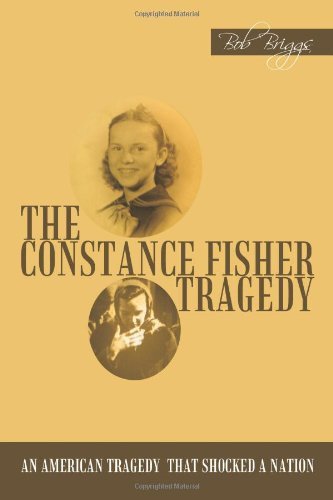On March 8, 1954, Constance Fisher drowned her
three children in the bathtub of her family's second-floor apartment
in Waterville.
The 24-year-old Fisher, distraught and severely
depressed, took the life of her 11-month old baby, then wrapped the
child in a blanket in her crib.
Daniel Fisher, 4, was the second child to die
before being placed on the couch in a blanket.
When the oldest child, Richard, 6, arrived home
from school anxious to see his mother, she offered to run a warm bath
for him on the chilly afternoon.
After playing with him for a few minutes in the
tub, she put her hand around his neck and submerged his head under
water.
He struggled so hard that Constance had to climb
into the tub with him to force him under.
Then she drank part of a bottle of poisonous
shampoo and crawled under the bed in an electric blanket.
The deaths became a state and national scandal as
people reacted with emotions ranging from outrage to sympathy.
Why did she do it?
In this stunning book, author Bob Briggs of
Hallowell tries to answer that question and a great many others as he
relates Fisher's story against the backdrop of the Augusta State
Hospital and its regimen of fresh air, recreation, good food from the
hospital's working farm and medications available at the time.
Constance Fisher was found by the court to be not
guilty by reason of insanity in the deaths of the three children. She
was sent to the state hospital where she was both a curiosity among
other patients and a patient much in demand by doctors because of her
highly-publicized actions.
The work Briggs put into this book is astounding.
He gained access to Fisher's medical records after trying for three
months. He was stonewalled by people who worked at the old state
hospital while Fisher was there and had to take a number of routes to
gain information.
He scoured old newspapers for details of the
tragedy and talked to people who remembered Constance, including her
sister, Louise Bowker.
Briggs spends much of his book describing the
history of the asylum movement that began around 1820 as a way to free
the mentally ill from jails, back rooms in private homes, and other
places where they were often abused and given no help at all.
Mental hospitals were built to remove the
patients from the dysfunctional environments that were contributing to
their illnesses.
The hospitals — which included the old state
hospital that later became the Augusta Mental Health Institute —
featured large working farms where patients could achieve a sense of
accomplishment and benefit from outdoor activity.
There also were fruit trees, shade trees, shrubs
and other landscaping to encourage peace of mind.
Briggs relies heavily on the work of Dr. Isaac
Ray, a superintendent at the hospital who believed the brain could
become ill just like any other organ.
An agitated or sick brain, he said, would respond
to a healthy lifestyle, sports and games, music and art, among other
activities.
Constance Fisher spent five years in these
surroundings, along with about 1,500 other patients in more than 50
buildings. The hospital superintendent at the time was Dr. Francis
Sleeper, an unabashed promoter of the institution.
He invited members of the community to picnics on
the grounds, sent out press releases and helped patients start a
newspaper, and gave keys to the buildings to Brooks Hamilton, a
reporter at Kennebc Journal, telling him to roam the hospital at-will,
day or night.
Constance's diagnosis changed over the years from
paranoid schizophrenic to postpartum psychosis to sociopathic to
dissociative disorder, whereby she stood outside herself and watched
as she killed her children.
One thing bothered her doctors. She never showed
remorse for what she'd done. Instead, she said the children were
better off because she couldn't care for them properly and now they
were in heaven.
A voice, a presence, kept telling her that, she
said.
Her depression and nervous spells began the
winter before she took her children's lives, right after she stopped
breast-feeding her baby.
She made visits to her family doctor and to a
psychiatrist. Both told the family to move from a two-room cabin where
they were living on a pond with no running water and no toilet. In the
winter, they chipped ice to draw water.
The family moved to Waterville where they would
be closer to relatives and a downtown.
Constance's moods went up and down. Some days she
couldn't get out of bed; other days she functioned through confusion,
sadness and extreme anxiety. And there were days when she was on a
high, unable to sit still.
Five years after entering the state hospital, she
was released, despite some misgivings from her medical team. There was
no real follow-up plan for her, and no real regimen for continued
sanity.
She was the poster child for the good work at the
state hospital and its methods, which included insulin shock therapy
that nearly killed Constance at one point. That therapy was later
abandoned by the hospital because it was ineffective.
It was recommended by at least one doctor that
Constance be sterilized, a common procedure in those years.
Instead, Constance went to the new home in
Fairfield her husband had built for her and immediately became
pregnant.
Two years later she gave birth to a second baby,
and within three years, a third child. They were Kathleen, Michael and
Natalie.
When those children were 6 years old, 4 years
old, and 9 months, their mother again filled the bathtub and drowned
all three. Her husband Carl came home and saw his beautiful older
daughter face down in the tub. He ran out of the house, never to
return again.
It was Father Joseph Brannigan who went in and
found not only the three children, but Constance in a coma from an
overdose of pills. The house was a shambles of rotting food, toys and
clutter.
Brannigan later left the priesthood and started a
halfway house for the mentally ill in Portland. He later became a
legislator and state senator.
This time, Constance knew she was in the state
hospital for good. Her condition worsened and she spent most of her
time watching television and mumbling to herself. She didn't mingle
with other patients as she had before, and visitors — including Carl —
came less frequently.
On the night of Oct. 1, 1973, she slipped off the
hospital grounds and threw herself into the Kennebec River. Her body
was found nearly a week later in South Gardiner.


